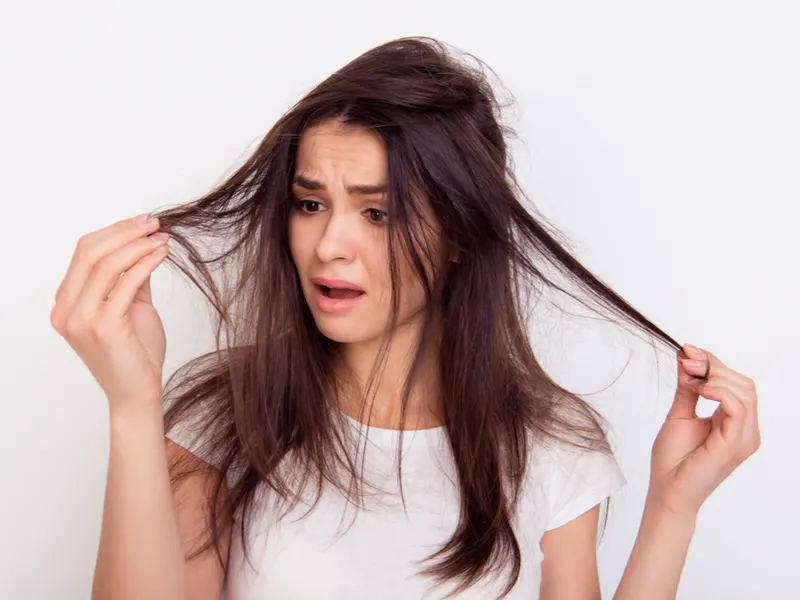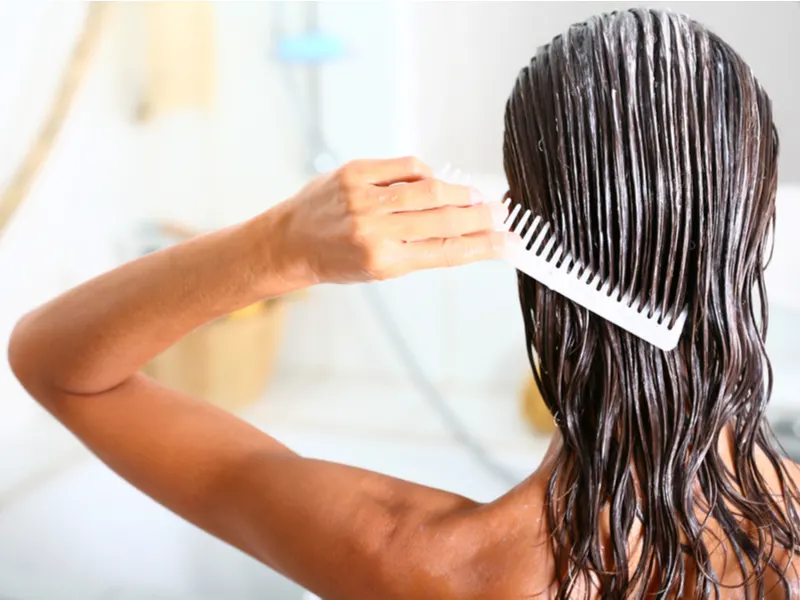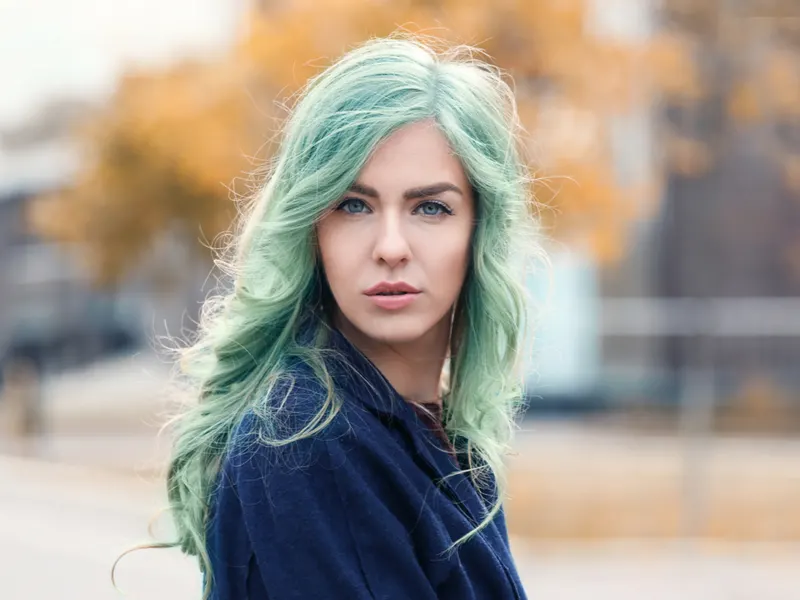Jump to:
Dying your hair is a time and financial commitment, so it’s frustrating to experience hair color fading. We’ll help you understand the causes of fading so you can keep your locks looking salon-fresh for longer.
Is Your Hair Color Fading? Don’t Panic.

Roman Samborskyi/Shutterstock
Hair color fading is when hair dye gradually leaves the hair follicles due to environmental factors or the dye’s natural release over time. In this article, we’ll talk about:
- Causes of hair fading
- How to prevent fading
Often, more than one factor is the reason for color fading, and not taking action can cause you to spend unnecessary money to dye your hair more frequently. We’ll teach you how to prevent doing so.
The 9 Main Causes of Fading Hair Color
Read through the following reasons to get to the bottom of why your hair color keeps fading.
1. Shampooing Your Hair Too Often
Overusing shampoo is one of the most common reasons people struggle with fading hair color. Depending on the quality of hair dye you use and whether that dye is temporary or permanent, you can expect the dye to remain color fresh for 6 – 30 washes.
That means if you wash your hair every day, your hair dye will remain fade-free for a mere month at most. And that’s not even considering people who take more than one shower per day.
So, we recommend following what experts say about reducing shampoo frequency. Not only will doing so help preserve your hair color for longer, but you may also notice that your hair becomes less oily, as your body will produce up to 50% fewer extractable oils.
Read Next: How Often Should You Wash Hair?
2. Rinsing Your Hair With Hard Water
If you shampoo your hair often and bathe with hard water, it’s a recipe for disaster for speeding up hair color fading. The reason is that hard water contains large amounts of magnesium and calcium.
These nutrients can have detrimental impacts on hair dye and your locks as a whole, given that they strip away natural oils. The result? Brittle hair and faded color. Furthermore, hard water creates build-up, which can spark hair loss.
Should you test your water and realize that it falls into the hard water category, install a water softening system. Then, re-dye your hair and test it out. If hard water was the issue, we know you’ll be amazed by how long your hair dye lasts before fading!
Read Next: How to Boil Hard Water to Wash Hair
3. Using Harsh Shampoos
You already know the importance of reducing shampoo sessions to preserve your hair color, but your shampoo’s quality also matters. Sulfates are a common ingredient in shampoo, as they wash away dead skin cells and grime.
However, because of their deep cleansing properties, they often remove a bit of hair dye with each use. So you should avoid shampoos that contain ingredients such as:
- Ammonium laureth sulfate
- Sodium laureth sulfate
Some shampoo bottles contain “color safe” labels to make it easier. Bottles that describe their product as “gentle” are also often sulfate-free. As a bonus, your health will benefit since sulfates can cause lung issues.
Most likely, you’ll spend a little more money on sulfate-free shampoo, as cheap products usually contain it. However, you’ll save money in the long run by not having to dye your hair so frequently from fast fading.
Read Next: 10 Shampoo Ingredients to Avoid
4. Misusing Hot Styling Tools
It’s easy to lay a flat iron on your hair without protecting it when you’re in a rush or don’t know better. However, doing so will fade your hair color. The reason has a scientific basis.
When you apply heat to your hair, its moisture converts to steam. That steam then becomes stuck in the hair shaft, creating “hair bubbles.” Unfortunately for hair dye, this accelerates fading.
Examples of hot styling tools that can cause hair fading are:
- Curling iron
- Flat iron
- Blow dryer
The good news is that people with hair dye don’t have to avoid hot styling tools altogether. Instead, purchase a high-quality heat protectant spray. By applying a thin layer of this solution to your hair just before styling your hair with heat, you should notice a difference in how fast your hair fades.
5. Swimming in Chlorine-filled Water
If you frequent swimming pools, chlorine could be making your hair fade. Chlorine is a poisonous gas that can cause respiratory problems, watery eyes, and vomiting if you encounter it in high concentrations.
Furthermore, human hair acts as a sponge, soaking in the water you emerge it in. That’s especially the case for people with high-porosity hair, where cuticles spread apart so much that they quickly absorb moisture.
The good news is that you don’t have to avoid swimming in chlorinated water altogether. Instead, wear a shower cap or rinse off your hair after getting out of the pool.
Chlorine sets into hair the most once it dries. By catching it and rinsing your hair well while it’s still wet, you’ll significantly reduce the hair fading damage that chlorine can cause.
6. Bathing in Hot Water
There’s nothing like a hot shower to relax the body. Unfortunately, such water is terrible for dyed hair, as it increases how quickly your color will begin to fade.
The reason for this is that hot water opens your cuticles. By doing so, your hair dye can literally release the hold it had on your hair, washing it away with the dirt and oil you wanted to remove from your hair.
For this reason, it’s best to use warm or lukewarm water on your hair. Alternatively, if you want to experience the cold water benefits that everyone’s talking about, taking cold showers is an even better way to preserve your hair dye.
7. Jumping Into the Ocean With Dry Hair
We’ve already established that your hair is like a sponge, with cuticles that absorb water according to their spacing and the water temperature. So, it might make sense now when you think of your hair in the context of saltwater.
If you swim in the ocean with dry hair, your hair will naturally soak up the ocean’s water. Salt is terrible for hair dye, and you can expect your hair to fade faster if you bathe in saltwater often.
The good news is that you can use the following strategies to decrease the ocean’s damage to your hair color:
- Soak your hair in regular water before going into the ocean
- Running conditioner through your wet hair
- Braiding your hair
By harnessing all three of these strategies before going into the ocean (or the pool, for that matter), you’ll preserve your hair’s color for longer.
8. Not Protecting Your Hair From the Sun
Dye or no dye, keeping your hair protected from the sun is crucial for it to retain its dyed or natural color. You already know the powerful effect UVA and UVB rays can have on darkening your skin. So, it’s unsurprising that they can impact your hair’s color.
In the case of hair dye, the sun fades the color from your hair. But it doesn’t end there. Instead, if you stay out in the sun for long periods, it’ll eventually reach your natural hair pigments, turning your hair into all kinds of brassy and unwanted colors.
So, use one or more of the following strategies to protect your hair from the sun:
- Spray sunscreen with a high SPF on your hair
- Use sunscreen on your scalp
- Cover your hair with a hat
9. Toning With a Poor-Quality Product
Hair toners can make or break your hair dye experience. They’re an essential product in the hair dyer’s toolkit, given that they manage brassy spots, helping your dyed hair blend seamlessly with your hair’s natural color.
However, using a poor-quality toner can cause your hair to fade quicker. Furthermore, light and semi-permanent toners also don’t hold the dye as well to your hair, no matter their quality.
If you spend a lot of time in the sun and haven’t ever protected your hair from it, you also may experience increased oxidation. So, applying high-quality purple toner can help preserve your hair’s color in between salon visits.
Tips to Prevent Your Hair From Fading

plprod/shutterstock
We’ve already shared strategies for changing some of your hair care habits and environmental factors. So, once you make those changes, below are some more tips to help you preserve your hair color.
Apply Permanent Color
Permanent color is the way to go for hair color that lasts a long time, given that the dye reaches deep inside your hair shaft. In contrast, demi-permanent hair color only enables the dye to access the area around your hair shaft.
Use Deep Conditioners
Deep conditioners are an excellent way to prevent hair color fading because they moisturize the hair. As a result, your hair will retain dyes better, given that it’ll be stronger and healthier compared to dry, non-deep-conditioned hair.
Set a Schedule
Let’s face it—no matter how well you care for your dyed hair, hair grows out, and dyes will eventually fade. Once you change your hair care routine according to what we discussed here, figure out how long it takes for the dye to fade naturally and set up a hair dye schedule accordingly.
Frequently Asked Questions

Africa Studio/Shutterstock
If you still have questions about hair Color fading, read on for answers to popular inquiries.
How can I fix my faded hair color?
To fix your faded hair color without re-dying it, use a hair gloss treatment, add concealer to your roots, and remove any build-up. You can also try an at-home cranberry juice rinse.
How long does permanent hair color take to fade?
You can expect your permanent hair color to fade in 7 – 8 weeks. However, unlike demi-permanent hair color, the dye will never fully fade from your hair.
Can I dye over dyed hair?
Yes, you can dye over dyed hair as long as you wait two weeks after the last time you dyed it. That way, you reduce the chance of hair damage.
Which hair dye lasts the longest?
Brown hair dye tends to have the longest-lasting lifespan, although the type and quality of the dye you choose have a huge impact. Warm and cool brown shades are both excellent brown hair dyes, giving you an array of color choices.
Why is my hair color fading fast?
Your hair may be fading fast because you didn’t let the hair color stay on long enough. Alternatively, environmental factors could be impacting it, such as bathing in hot or hard water and shampooing your hair too often.
So, What Is Hair Color Fading?
Fast hair color fading is an avoidable scenario, provided that you avoid the environmental factors that cause it. In most cases, it will cost you little to no money to prevent hair color fading. So, start making the changes we suggested and see how they help preserve your hair color.
